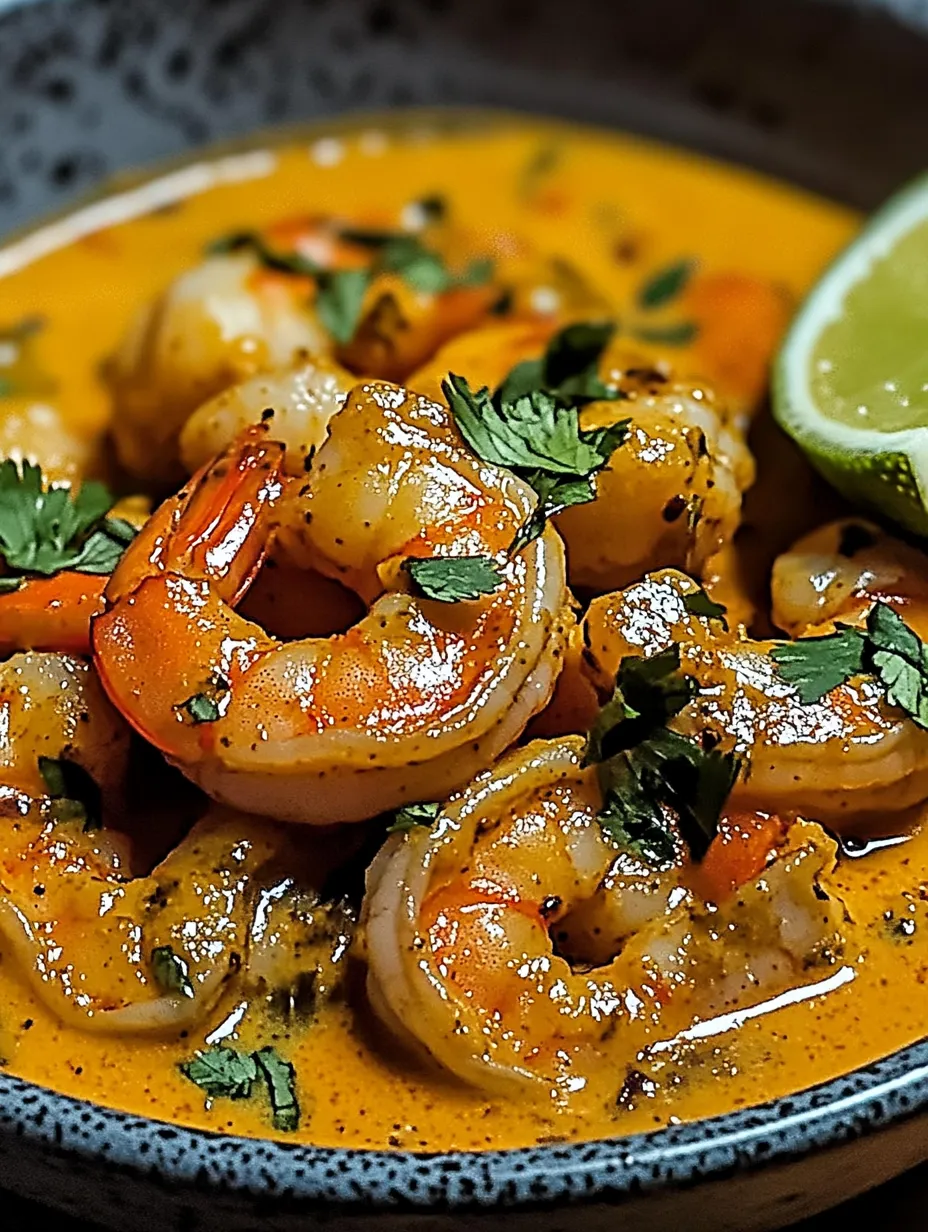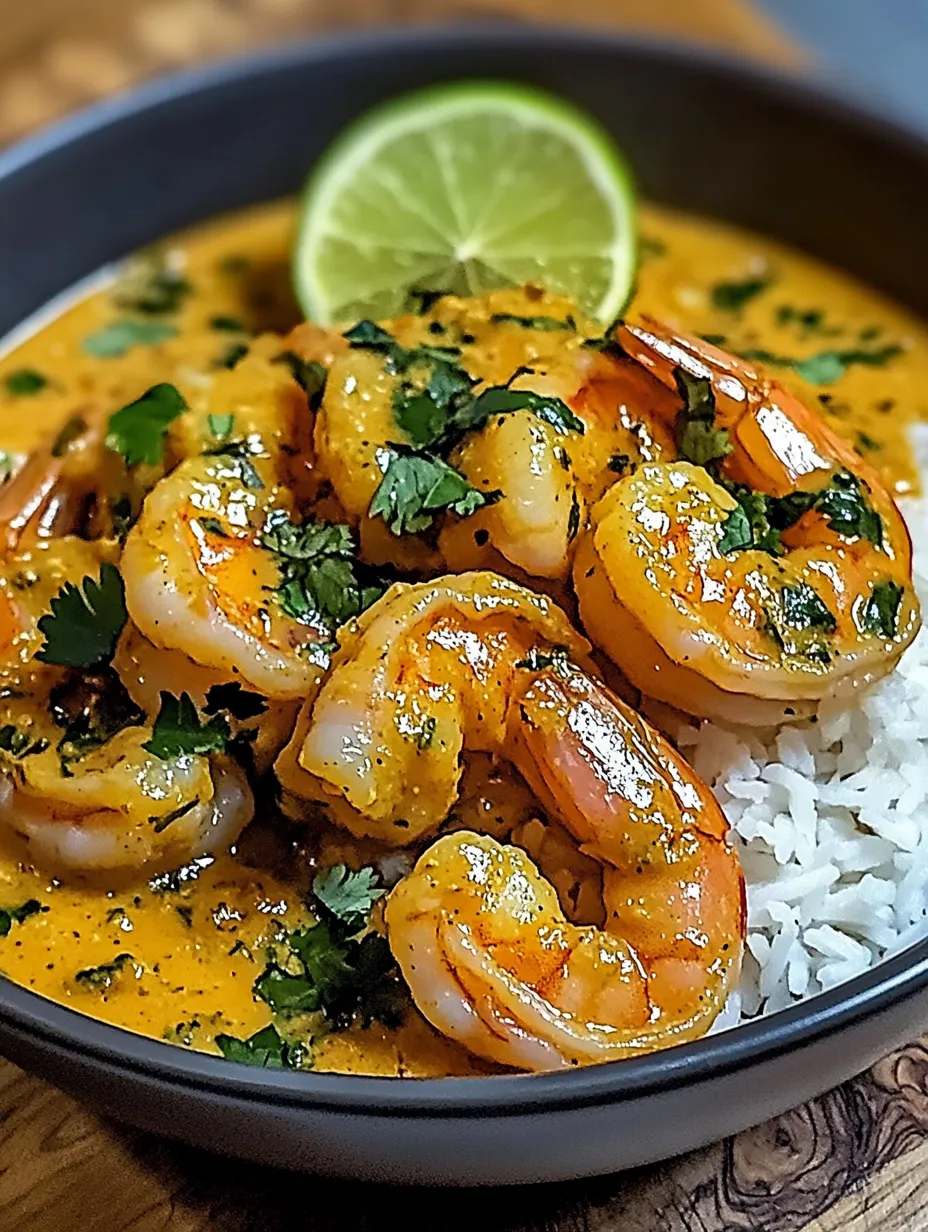 Pin it
Pin it
Coconut curry shrimp transports your taste buds to tropical shores with its perfect balance of creamy, spicy, and tangy flavors. This vibrant dish combines plump, tender shrimp with a luscious coconut curry sauce that's simultaneously comforting and exotic. The aromatic blend of spices and fresh ingredients creates layers of complexity that belie how quickly and easily this impressive meal comes together, making it perfect for both weeknight dinners and special occasions.
Tropical Treasure
- Quick Escape: Experience island flavors without leaving your kitchen
- Weeknight Wonder: Ready in under 30 minutes from start to finish
- Flavor Depth: Complex taste profile that seems like it simmered for hours
I discovered this recipe during a particularly brutal winter when I was desperately missing warmer climates. The combination of fragrant spices and tropical coconut immediately lifted my spirits, creating a mini vacation at my dinner table. My skeptical husband, who claims to dislike curry, took one bite and immediately asked for seconds. Now we make this dish whenever we need a quick mood boost or have guests to impress with minimal effort. The vibrant colors and bold flavors make everyone feel like they're dining at an upscale restaurant rather than our kitchen table.
Quality Components
- Fresh Shrimp: Look for plump, translucent raw shrimp without any ammonia smell
- Coconut Milk: Full-fat provides essential richness and body to the sauce
- Fresh Ginger: Adds irreplaceable brightness and warmth that powder can't match
- Curry Powder: The backbone of flavor that determines the character of your dish
- Lime Juice: The final touch that balances the richness with crucial acidity
 Pin it
Pin it
Culinary Choreography
- Sauce Foundation:
- Heat two tablespoons coconut oil in a large skillet over medium heat until shimmering. Add one finely diced medium onion and cook for 4-5 minutes until softened and translucent but not browned. Add three minced garlic cloves and one tablespoon freshly grated ginger, cooking for just 30 seconds until fragrant. This brief cooking prevents the garlic from becoming bitter while releasing its essential oils. Next comes the magic: add two tablespoons curry powder, one teaspoon turmeric, and one teaspoon cumin, stirring constantly for one minute. This toasting step blooms the spices, transforming them from flat, dusty powders into aromatic wonders that will infuse the entire dish.
- Creamy Development:
- Pour in one 14-ounce can of full-fat coconut milk, stirring well to incorporate the spices. Bring the mixture to a gentle simmer, then reduce heat to medium-low and cook for about 5 minutes until slightly thickened. The sauce should coat the back of a spoon but still remain pourable. Add one tablespoon fish sauce (or soy sauce for a vegetarian option) and the juice of half a lime. These ingredients provide the crucial umami depth and bright acidity that balances the richness of the coconut milk. Taste and adjust seasoning, remembering that the shrimp will add their own sweet brininess to the final dish.
- Shrimp Perfection:
- While the sauce simmers, prepare one pound of large shrimp that have been peeled and deveined. Pat them dry with paper towels to ensure proper searing. Season lightly with salt and pepper. In a separate skillet, heat one tablespoon olive oil over medium-high heat until nearly smoking. Add the shrimp in a single layer, being careful not to crowd the pan (work in batches if necessary). Cook for approximately 1-2 minutes per side until they just turn pink and begin to curl. Remove immediately to prevent overcooking. Remember that the shrimp will continue cooking slightly when added to the warm sauce.
- Harmonious Finish:
- Gently fold the cooked shrimp into the coconut curry sauce, coating each piece evenly. Simmer together for just one minute to marry the flavors without toughening the shrimp. Remove from heat and finish with an additional squeeze of fresh lime juice to brighten the dish. Sprinkle generously with roughly chopped fresh cilantro, which adds color contrast and herbaceous notes that complement the curry beautifully. For presentation, garnish with thinly sliced red chili for a pop of color and additional lime wedges on the side for those who enjoy extra tanginess.
My mother, who rarely experiments beyond her traditional cooking, visited during a week when this curry was on our menu. She watched skeptically as I prepared it, questioning the combination of flavors and insisting she would "just have a taste." That taste turned into a full bowl, followed by her requesting the recipe. Now in her 70s, she's become known in her retirement community for her "famous curry," proving that wonderful food can bridge generations and create new traditions at any age.
Serving Inspiration
Serve this curry over fragrant jasmine rice which absorbs the sauce beautifully. For a lower-carb option, cauliflower rice provides the same sauce-soaking benefit. Warm naan bread makes the perfect tool for scooping up every last bit of the delicious sauce. For a complete meal, add a simple cucumber salad dressed with rice vinegar and a touch of sugar to provide cooling contrast to the warm curry. A cold lager beer or crisp Riesling complements the spices perfectly.
Flavorful Variations
Transform this dish into a vegetarian delight by replacing shrimp with firm tofu cubes or hearty chunks of roasted vegetables like cauliflower and sweet potato. Create a fiery version by adding a diced jalapeño with the onions or a sprinkle of red pepper flakes. For a heartier meal, add diced red bell pepper and green peas to the sauce before folding in the shrimp. Southeast Asian flavor lovers can add a tablespoon of Thai red curry paste along with the dry spices for a different flavor profile.
 Pin it
Pin it
Storage Strategy
This curry keeps beautifully in an airtight container in the refrigerator for up to three days, with flavors actually improving overnight as they meld together. Reheat gently on the stovetop over medium-low heat, adding a splash of water or coconut milk if the sauce has thickened too much. While you can freeze the curry sauce separately, cooked shrimp doesn't freeze well, becoming tough and rubbery when thawed. For meal prep, consider making a double batch of sauce and freezing half without shrimp for up to three months.
I created this recipe for my husband's birthday dinner during a particularly tight financial month when dining out wasn't an option. His face lit up with the first bite, and he declared it better than any restaurant curry he'd ever had. That moment taught me something valuable about cooking: sometimes our constraints lead to our greatest creativity. This dish has since become our celebration meal, marking special occasions with flavors that feel indulgent and special regardless of how simple they are to prepare.
Frequently Asked Questions
- → Can I make this coconut curry shrimp recipe with frozen shrimp?
- Yes, you can use frozen shrimp in this recipe. Simply thaw them completely first by placing them in a colander under cold running water for 5-7 minutes, or overnight in the refrigerator. Pat them dry thoroughly before cooking to ensure they sear properly rather than steam. Frozen shrimp are often pre-peeled and deveined, which can save preparation time.
- → What type of curry powder works best for this dish?
- This recipe works well with any standard curry powder blend, but Madras curry powder will give you a slightly spicier result, while a mild curry powder creates a gentler flavor profile. Yellow curry powder provides that classic golden color. If you enjoy specific regional flavors, you could substitute with Thai curry paste (red, yellow, or green) instead of curry powder—just reduce the amount to 1-2 teaspoons since curry paste is more concentrated.
- → How can I make this coconut curry shrimp vegetarian?
- To make a vegetarian version, replace the shrimp with 14 oz (400g) of firm tofu (pressed and cubed) or 2 cups of mixed vegetables like bell peppers, zucchini, and carrots. Use soy sauce or tamari instead of fish sauce. For a vegan option, ensure your curry powder doesn't contain any animal products. The cooking process remains the same, though vegetables may need varying cooking times depending on their density.
- → Can I prepare components of this dish ahead of time?
- Yes, this curry is great for meal prep. You can make the sauce up to 2 days ahead and store it in the refrigerator. When ready to serve, gently reheat the sauce and cook the shrimp fresh just before serving. For the freshest result, keep the shrimp separate until serving time. If you need to reheat the entire dish, do so gently on low heat just until warmed through to avoid overcooking the shrimp.
- → What can I serve with coconut curry shrimp besides rice?
- While jasmine rice is a classic pairing, you have several delicious alternatives. Try serving with cauliflower rice for a low-carb option, rice noodles or zucchini noodles for a different texture, or quinoa for added protein. Warm naan bread or roti are excellent for sopping up the sauce. For a complete meal, add a simple cucumber salad with rice vinegar dressing on the side to balance the rich curry.
- → Why is my coconut curry sauce too thin or too thick?
- If your sauce is too thin, simmer it uncovered for a few extra minutes to reduce and thicken. You can also make a slurry with 1 teaspoon cornstarch mixed with 1 tablespoon cold water and stir it into the simmering sauce. If your sauce is too thick, thin it with additional coconut milk, a splash of chicken broth, or water. The consistency should be similar to a creamy soup – able to coat the back of a spoon but still fluid enough to pour.
